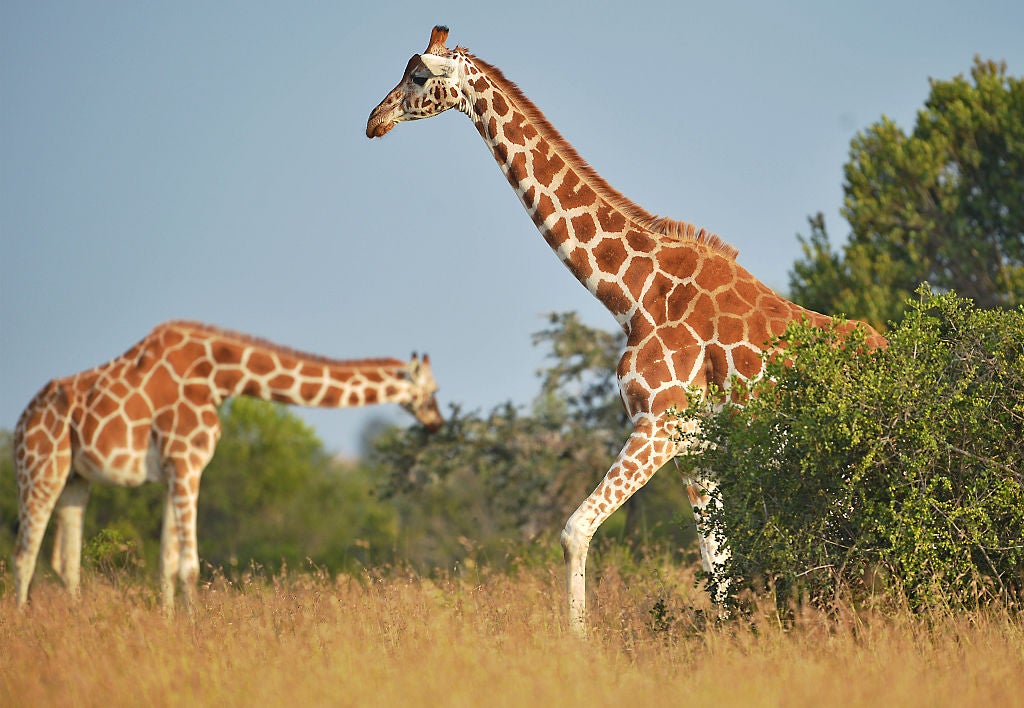Giraffes being pushed towards 'silent' extinction
The world’s tallest animal is now classed as vulnerable on the latest list of threatened species

Your support helps us to tell the story
From reproductive rights to climate change to Big Tech, The Independent is on the ground when the story is developing. Whether it's investigating the financials of Elon Musk's pro-Trump PAC or producing our latest documentary, 'The A Word', which shines a light on the American women fighting for reproductive rights, we know how important it is to parse out the facts from the messaging.
At such a critical moment in US history, we need reporters on the ground. Your donation allows us to keep sending journalists to speak to both sides of the story.
The Independent is trusted by Americans across the entire political spectrum. And unlike many other quality news outlets, we choose not to lock Americans out of our reporting and analysis with paywalls. We believe quality journalism should be available to everyone, paid for by those who can afford it.
Your support makes all the difference.Giraffes are being pushed towards a “silent” extinction due to illegal hunting and habitat loss, conservationists have said.
Numbers of the world’s tallest animal have plummeted 40 per cent in the past 30 years.
The threatened giant, which roams in southern and eastern Africa, is now classed as vulnerable on the latest global Red List of Threatened Species by the International Union for Conservation of Nature (IUCN).
A growing human population, increased farming and civil unrest have also contributed to a decline of 66,000 since 1985. There were estimated to be just 97,000 left in the wild as of 2015.
Julian Fennessy, co-chair of the IUCN’s Giraffe and Okapi Specialist Group, said: “Whilst giraffes are commonly seen on safari, in the media and in zoos, people – including conservationists – are unaware that these majestic animals are undergoing a silent extinction.
“With a decline of almost 40 per cent in the last three decades alone, the world’s tallest animal is under severe pressure in some of its core ranges across East, Central and West Africa.
“As one of the world’s most iconic animals, it is timely that we stick our neck out for the giraffe before it is too late.”
The assessment also revealed a worsening situation for African grey parrots, regularly kept as pets and with the ability to mimic human speech, which are now classed as endangered because of unsustainable trapping for trade and habitat loss.
More than 700 newly recognised bird species have been assessed for the new update of the Red List, with more than one in 10 found to be at risk of dying out.
Inger Anderson, IUCN director general, said: “Many species are slipping away before we can even describe them.
“This IUCN Red List update shows that the scale of the global extinction crisis may be even greater than we thought.”
She urged governments at the latest meeting of the United Nations Convention on Biological Diversity, which aims to ensure the conservation and sustainable use of nature, to step up their efforts to protect the planet's wildlife.
Wild oats, barley, mango and other wild relatives of crops that humans rely on have been assessed for the first time for the Red List. The species are increasingly important to food security, as they could provide new varieties that are more resilient to extreme conditions such as drought.
The assessment listed four mango species as endangered and the Kalimantan mango was classed as extinct in the wild.
A wild relative of the chickpea that is native to Iran and Turkey has been listed as endangered due to the conversion of its habitat for agriculture.
A Japanese relative of asparagus, hamatamabouki, is also listed as endangered due to habitat loss, while the anomalus sunflower is classed as vulnerable.
Additional reporting by PA
Join our commenting forum
Join thought-provoking conversations, follow other Independent readers and see their replies
Comments